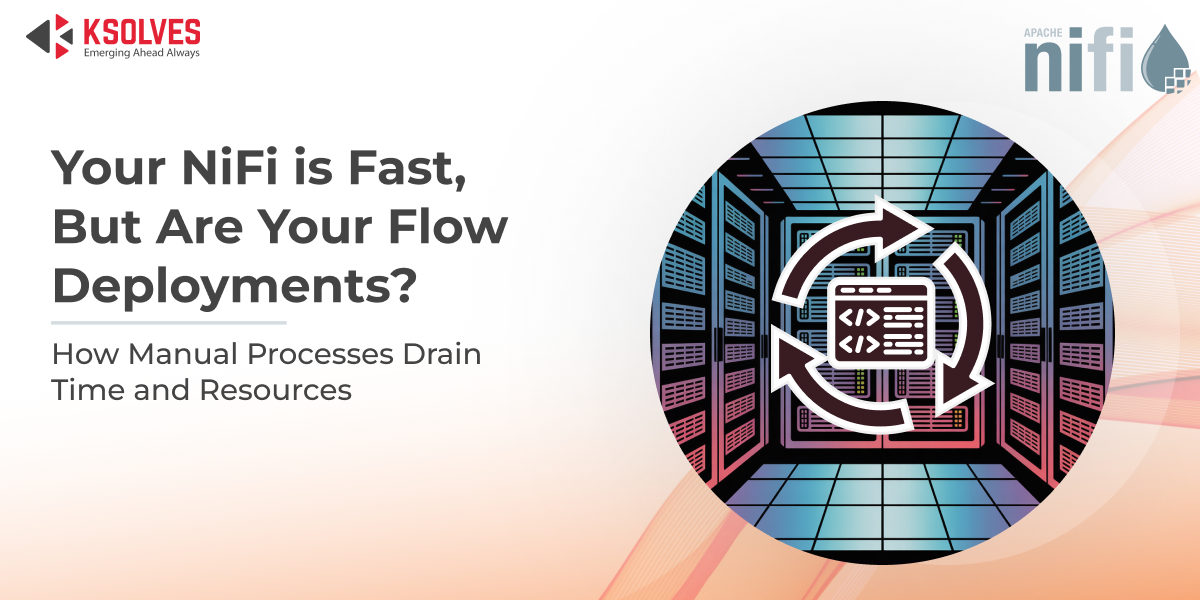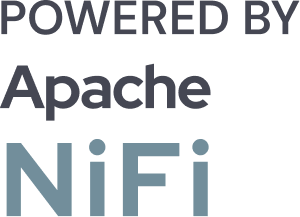The Hidden Cost of Developer Time in Apache NiFi Flow Deployment and Promotions
![]()

Apache NiFi is a game-changer for building scalable, low-code data pipelines. It empowers teams to ingest, route, and transform data in real time. But there’s a catch: while NiFi excels at data flow design, its deployment and promotion across environments are often stuck in the past.
Behind the scenes, DevOps and engineering teams spend countless hours manually exporting, configuring, and promoting flows across Dev, QA, and Production. These tasks, while critical, are repetitive, error-prone, and not the best use of highly-skilled developer time.
In this blog, we’ll uncover the hidden costs of these manual processes and highlight how organizations can save developer hours, reduce errors, and drive operational efficiency through automation.
The Real Problem: Manual NiFi Flow Deployments and Promotions Are Costly
Here’s how manually deploying and promoting NiFi flows can cost you:
1. Time Sink for Developers
Developers often spend hours per week repeating the same tasks:
- Exporting dataflows from one environment
- Modifying parameters manually for staging or production
- Troubleshooting configuration differences
These aren’t strategic tasks. They don’t create new value. Yet, they consume senior developer bandwidth, the very people you want solving complex data problems or optimizing system performance.
2. Delayed Releases
Manually promoting NiFi flows slows down your release cycle. Each environment requires careful re-validation of configurations, which introduces delays, especially when hotfixes or urgent dataflow updates are needed in production. A lack of automation leads to delayed time-to-market for business-critical data pipelines.
3. High Operational Overhead
As the number of flows grows, so does the chaos:
- Developers must maintain environment-specific templates.
- Admins manually update controller services and parameter contexts.
- Cross-team communication becomes a bottleneck.]
All of this leads to increased operational costs, inconsistent deployments, and frustrated teams.
Strategic Risk for Leadership: Why CIOs and CTOs Can’t Ignore the Cost of Manual NiFi Deployments and Promotions
For technology leaders, investments in platforms like Apache NiFi are made with one goal in mind: to accelerate innovation through seamless data movement. But if your development teams are bogged down by repetitive, manual flow deployment processes, you’re not getting the return you were promised.
Here’s where the strategic risk lies:
1. Diminishing ROI on NiFi Investments
NiFi is designed to be fast and intuitive, but when flow deployment cycles are slow, inconsistent, and heavily manual, that agility is lost. You’re investing in a high-performance engine, but the gears are jammed by outdated processes. The result? Slower delivery of data products, missed business opportunities, and underutilized infrastructure.
2. Developer Burnout
Your best engineers didn’t sign up to copy-paste flow templates and reconfigure parameters for each environment. When high-value talent is routinely pulled into mundane, repetitive work, motivation drops, and so does retention. Over time, this leads to a loss of institutional knowledge and rising costs of rehiring and onboarding.
3. Compliance and Audit Vulnerabilities
Manual NiFI flow deployments and promotions introduce configuration inconsistencies that make governance difficult. Without a standardized, version-controlled promotion process, you risk audit failures, a lack of traceability, and compliance breaches, especially in regulated industries like healthcare, finance, and telecom. These aren’t just technical issues; they’re board-level concerns.
4. Scalability Becomes a Bottleneck
As your data ecosystem grows, so does the complexity of managing environments, configurations, and flow versions. Without automation, your ability to scale becomes constrained by human bandwidth. Teams spend more time maintaining existing flows than building new ones, leading to stalled innovation and growing technical debt.
Pain Points for DevOps & DataOps Teams: The Hidden Friction in NiFi Flow Deployment and Promotions
For DevOps and DataOps engineers, Apache NiFi offers tremendous flexibility in designing data pipelines, but that flexibility doesn’t extend to flow deployment and promotion. When it comes to promoting flows across environments, teams are left stitching together manual processes that were never designed to scale.
Here are the common pain points that slow down delivery and introduce risk:
- Continuous Back and Forth Between NiFi UI for Multiple Instances
Managing flows across development, staging, and production environments often requires teams to juggle multiple NiFi UIs. Engineers must manually export flows from one instance, import them into another, and create and configure variables, controller services, and parameters. This constant back-and-forth is time-consuming, error-prone, and distracts from strategic DevOps initiatives.
- The Risk of Flow Configuration Drift
Without a standardized and version-controlled flow promotion process, there’s a constant risk of configuration drift, where each environment slowly diverges due to manual edits and inconsistencies. This leads to unpredictable behavior in production, harder debugging, and time lost reconciling differences between environments.
- Manual Recovery and Rollbacks
If a promoted flow breaks in production, recovery is rarely instant. Rolling back a NiFi flow often involves re-importing older flow versions, reconfiguring flow parameters, variables, and controller services, and hoping the previous setup is still valid. The lack of built-in versioning and automation turns what should be a quick rollback into a fire drill, costing time, confidence, and sleep.
These challenges don’t just delay releases; they create friction between development and operations teams.
Also Read: Scale Apache NiFi Without Growing Teams Using Data Flow Manager
The Best Practices for Reliable and Faster NiFi Flow Deployments and Promotions
Transitioning from manual NiFi deployments to a mature, scalable process requires a strong foundation. Whether you’re working in a small data team or managing complex pipelines across multiple environments, these best practices are essential for consistency, auditability, and speed.
Here’s what that foundation looks like:
1. Template-Based Standardization
At the heart of any scalable NiFi architecture is reusability. By creating and promoting standardized flow templates, teams ensure that best practices are consistently applied across environments and projects.
Templates eliminate ad-hoc flow design, reduce duplication of effort, and help onboard new developers faster. Most importantly, they establish a single source of truth for how specific data pipelines should be structured.
2. Externalized Configuration Management
Using parameter contexts allows you to decouple your flow logic from environment-specific settings. Whether it’s database credentials, hostnames, or endpoint URLs, externalizing configurations ensures that the same flow can be promoted across Dev, QA, and Production without modification.
This dramatically reduces the chances of errors during deployment and makes the promotion process cleaner, more reliable, and far easier to audit.
3. Version Control and Change Tracking
Bringing GitOps principles to NiFi means applying the same discipline of versioning, rollback, and auditability that’s common in modern software development.
By tracking each flow change – who made it, when, and why – you gain a full historical view of your pipeline evolution. This makes debugging easier, audits smoother, and rollback seamless when things go wrong. Change management becomes structured, not guesswork.
While these practices form a solid foundation, managing them manually across multiple environments can still be resource-intensive and error-prone.
This is where Data Flow Manager steps in.
Data Flow Manager: A Smarter Way to Manage NiFi Flow Deployments and Promotions
Designed with DevOps scalability and administrative simplicity in mind, Data Flow Manager (DFM) is built to streamline and enable NiFi flow deployment and promotion in minutes, without requiring you to switch between NiFi UIs for multiple instances. Also, it eliminates the need for manually creating and configuring the controller services for each NiFi flow.
Without custom scripts or manual intervention, Data Flow Manager enables your team to:
- Deploy and promote NiFi flows across Dev, QA, and Production in minutes.
- Maps and lists all environment-specific parameters in one place
- Track every change with built-in versioning and audit trails
- Rollback instantly in case of errors or failed flow deployments and promotions
It acts as a centralized command center for NiFi flow management—eliminating the risk of human error, accelerating delivery timelines, and giving teams the freedom to focus on building, not babysitting.
Business Impact of Automating NiFi Flow Deployment and Promotion
| Role | Key Benefits |
| CIO / CTO | – Boost in developer productivity
– Accelerated time-to-market for data initiatives – Reduced Total Cost of Ownership (TCO) |
| DevOps / DataOps | – Fewer outages and deployment errors
– Consistent, repeatable workflows – Confident version control and rollback |
| NiFi Administrators | – Less time spent on firefighting and manual fixes
– Smoother audits and compliance readiness – Greater focus on flow optimization |
Conclusion
Manual NiFi flow promotions may seem manageable at first, but they quietly drain time, introduce risk, and slow down innovation. As data ecosystems scale, the hidden costs, both technical and strategic, become impossible to ignore.
By embracing automation with tools like Data Flow Manager, organizations can streamline deployments, boost team productivity, and unlock the full potential of their NiFi investment. It’s not just an operational upgrade – it’s a strategic move toward faster, smarter, and more reliable data delivery.
![]()

